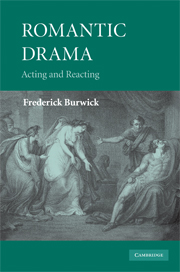Book contents
- Frontmatter
- Contents
- List of illustrations
- Acknowledgments
- Introduction
- 1 Periscopes into the theatre
- 2 Nationalism and national character
- 3 Genre: the realism of fantasy, the fantasy of realism
- 4 Acting: histrionics, and dissimulation
- 5 Transvestites, lovers, monsters: character and sexuality
- 6 Setting: where and elsewhere
- 7 Gothic and anti-Gothic: comedy and horror
- 8 Blue-Beard's castle: mischief and misogyny
- 9 Vampires in kilts
- Notes
- Bibliography
- Index
5 - Transvestites, lovers, monsters: character and sexuality
Published online by Cambridge University Press: 04 August 2010
- Frontmatter
- Contents
- List of illustrations
- Acknowledgments
- Introduction
- 1 Periscopes into the theatre
- 2 Nationalism and national character
- 3 Genre: the realism of fantasy, the fantasy of realism
- 4 Acting: histrionics, and dissimulation
- 5 Transvestites, lovers, monsters: character and sexuality
- 6 Setting: where and elsewhere
- 7 Gothic and anti-Gothic: comedy and horror
- 8 Blue-Beard's castle: mischief and misogyny
- 9 Vampires in kilts
- Notes
- Bibliography
- Index
Summary
As introduced in earlier chapters, the optical metaphors of the periscope and “Pepper's Ghost” were intended to conjure the experience of being in the theatre and witnessing the characteristic doubleness of performance. With the homosexual critic John Waldie as one periscopic eye-witness and the homophobic William Hazlitt as another, the present chapter may require a bit more effort to filter out present-day attitudes and acknowledge those of the late eighteenth and early nineteenth century. The phenomena of superimposed reflected and refracted images are given yet another metaphorical application in terms of representation of gender norms and transgressions. Members of the audience, then as now, would presumably exercise a high degree of confidence in their ability to recognize on stage the characterizations of dubious or deviant sexuality. Most often it was an easy matter. Gothic villains were readily exposed as sexual predators. Theatrical representations of fops and dandies typically lacked the polish and sophistication that they most probably possessed in the real world and were to acquire on the stage only much later in the century. There were, nevertheless, moments of ambiguity in the construction or constriction of predatory or homoerotic desire. The reflected images might depict a familiar world in which word and gesture conformed to readily recognizable behavior in courtship, but these might be confounded with refracted images of the dark other side, in which the sexual codes were strange and undecipherable.
- Type
- Chapter
- Information
- Romantic DramaActing and Reacting, pp. 115 - 150Publisher: Cambridge University PressPrint publication year: 2009



